A Nationwide Flood Forecasting System for Saudi Arabia: Insights from the Jeddah 2022 Event
Abstract
:1. Introduction
2. Materials and Methods
2.1. Atmospheric Model Domain and Setup
2.2. The Hydrological and Hydrodynamic Model Domain and Setup (CREST-HEC2D)
2.3. Validation Approach
2.3.1. WRF
2.3.2. CREST
2.3.3. HECRAS
3. Results
3.1. CREST Tuning
3.2. Validation of WRF Precipitation Predictions
3.3. Validation of CREST-HEC2D Discharge and Inundation Depths
4. Discussion
4.1. Performance of the Flood Warning System in Jeddah in November 2022
4.2. Remarks
5. Conclusions
Author Contributions
Funding
Data Availability Statement
Conflicts of Interest
References
- Dottori, F.; Szewczyk, W.; Ciscar, J.-C.; Zhao, F.; Alfieri, L.; Hirabayashi, Y.; Bianchi, A.; Mongelli, I.; Frieler, K.; Betts, R.A.; et al. Increased Human and Economic Losses from River Flooding with Anthropogenic Warming. Nat. Clim. Chang. 2018, 8, 781–786. [Google Scholar] [CrossRef]
- Hirabayashi, Y.; Tanoue, M.; Sasaki, O.; Zhou, X.; Yamazaki, D. Global Exposure to Flooding from the New CMIP6 Climate Model Projections. Sci. Rep. 2021, 11, 3740. [Google Scholar] [CrossRef]
- Hirabayashi, Y.; Mahendran, R.; Koirala, S.; Konoshima, L.; Yamazaki, D.; Watanabe, S.; Kim, H.; Kanae, S. Global Flood Risk under Climate Change. Nat. Clim Chang. 2013, 3, 816–821. [Google Scholar] [CrossRef]
- Kimura, Y.; Hirabayashi, Y.; Kita, Y.; Zhou, X.; Yamazaki, D. Methodology for Constructing a Flood-Hazard Map for a Future Climate. Hydrol. Earth Syst. Sci. 2023, 27, 1627–1644. [Google Scholar] [CrossRef]
- Cutter, S.L.; Emrich, C.T.; Gall, M.; Reeves, R. Flash Flood Risk and the Paradox of Urban Development. Nat. Hazards Rev. 2018, 19, 05017005. [Google Scholar] [CrossRef]
- Hapuarachchi, H.A.P.; Wang, Q.J.; Pagano, T.C. A Review of Advances in Flash Flood Forecasting. Hydrol. Process. 2011, 25, 2771–2784. [Google Scholar] [CrossRef]
- Khajehei, S.; Ahmadalipour, A.; Shao, W.; Moradkhani, H. A Place-Based Assessment of Flash Flood Hazard and Vulnerability in the Contiguous United States. Sci. Rep. 2020, 10, 448. [Google Scholar] [CrossRef] [PubMed]
- Hinge, G.; Hamouda, M.A.; Long, D.; Mohamed, M.M. Hydrologic Utility of Satellite Precipitation Products in Flood Prediction: A Meta-Data Analysis and Lessons Learnt. J. Hydrol. 2022, 612, 128103. [Google Scholar] [CrossRef]
- Zander, M.J.; Viguurs, P.J.; Sperna Weiland, F.C.; Weerts, A.H. Future Changes in Flash Flood Frequency and Magnitude over the European Alps. Hydrol. Earth Syst. Sci. Discuss. 2022, 2022, 1–21. [Google Scholar] [CrossRef]
- Fekete, A.; Sandholz, S. Here Comes the Flood, but Not Failure? Lessons to Learn after the Heavy Rain and Pluvial Floods in Germany 2021. Water 2021, 13, 3016. [Google Scholar] [CrossRef]
- Petrucci, O. Review Article: Factors Leading to the Occurrence of Flood Fatalities: A Systematic Review of Research Papers Published between 2010 and 2020. Nat. Hazards Earth Syst. Sci. 2022, 22, 71–83. [Google Scholar] [CrossRef]
- Acosta-Coll, M.; Ballester-Merelo, F.; Martinez-Peiró, M.; De la Hoz-Franco, E. Real-Time Early Warning System Design for Pluvial Flash Floods-A Review. Sensors 2018, 18, 2255. [Google Scholar] [CrossRef] [PubMed]
- Witze, A. Why Extreme Rains Are Gaining Strength as the Climate Warms. Nature 2018, 563, 458–460. [Google Scholar] [CrossRef] [PubMed]
- Yin, J.; Gao, Y.; Chen, R.; Yu, D.; Wilby, R.; Wright, N.; Ge, Y.; Bricker, J.; Gong, H.; Guan, M. Flash Floods: Why Are More of Them Devastating the World’s Driest Regions? Nature 2023, 615, 212–215. [Google Scholar] [CrossRef]
- Borga, M.; Gaume, E.; Creutin, J.D.; Marchi, L. Surveying Flash Floods: Gauging the Ungauged Extremes. Hydrol. Process. 2008, 22, 3883–3885. [Google Scholar] [CrossRef]
- Siccardi, F.; Boni, G.; Ferraris, L.; Rudari, R. A Hydrometeorological Approach for Probabilistic Flood Forecast. J. Geophys. Res. Atmos. 2005, 110. [Google Scholar] [CrossRef]
- Georgakakos, K.P. On the Design of National, Real-Time Warning Systems with Capability for Site-Specific, Flash-Flood Forecasts. Bull. Am. Meteorol. Soc. 1986, 67, 1233–1239. [Google Scholar] [CrossRef]
- Yano, J.-I.; Ziemiański, M.Z.; Cullen, M.; Termonia, P.; Onvlee, J.; Bengtsson, L.; Carrassi, A.; Davy, R.; Deluca, A.; Gray, S.L.; et al. Scientific Challenges of Convective-Scale Numerical Weather Prediction. Bull. Am. Meteorol. Soc. 2018, 99, 699–710. [Google Scholar] [CrossRef]
- Marchi, L.; Borga, M.; Preciso, E.; Gaume, E. Characterisation of Selected Extreme Flash Floods in Europe and Implications for Flood Risk Management. J. Hydrol. 2010, 394, 118–133. [Google Scholar] [CrossRef]
- Bannister, R.N.; Chipilski, H.G.; Martinez-Alvarado, O. Techniques and Challenges in the Assimilation of Atmospheric Water Observations for Numerical Weather Prediction towards Convective Scales. Q. J. R. Meteorol. Soc. 2020, 146, 1–48. [Google Scholar] [CrossRef]
- Hu, G.; Dance, S.L.; Bannister, R.N.; Chipilski, H.G.; Guillet, O.; Macpherson, B.; Weissmann, M.; Yussouf, N. Progress, Challenges, and Future Steps in Data Assimilation for Convection-Permitting Numerical Weather Prediction: Report on the Virtual Meeting Held on 10 and 12 November 2021. Atmos. Sci. Lett. 2023, 24, e1130. [Google Scholar] [CrossRef]
- Gourley, J.J.; Flamig, Z.L.; Vergara, H.; Kirstetter, P.-E.; Clark, R.A.; Argyle, E.; Arthur, A.; Martinaitis, S.; Terti, G.; Erlingis, J.M.; et al. The FLASH Project: Improving the Tools for Flash Flood Monitoring and Prediction across the United States. Bull. Am. Meteorol. Soc. 2017, 98, 361–372. [Google Scholar] [CrossRef]
- Price, D.; Hudson, K.; Boyce, G.; Schellekens, J.; Moore, R.J.; Clark, P.; Harrison, T.; Connolly, E.; Pilling, C. Operational Use of a Grid-Based Model for Flood Forecasting. Proc. Inst. Civ. Eng.—Water Manag. 2012, 165, 65–77. [Google Scholar] [CrossRef]
- Zanchetta, A.D.L.; Coulibaly, P. Recent Advances in Real-Time Pluvial Flash Flood Forecasting. Water 2020, 12, 570. [Google Scholar] [CrossRef]
- Douinot, A.; Roux, H.; Garambois, P.-A.; Larnier, K.; Labat, D.; Dartus, D. Accounting for Rainfall Systematic Spatial Variability in Flash Flood Forecasting. J. Hydrol. 2016, 541, 359–370. [Google Scholar] [CrossRef]
- Qi, W.; Ma, C.; Xu, H.; Chen, Z.; Zhao, K.; Han, H. A Review on Applications of Urban Flood Models in Flood Mitigation Strategies. Nat. Hazards 2021, 108, 31–62. [Google Scholar] [CrossRef]
- Krajewski, W.F.; Ceynar, D.; Demir, I.; Goska, R.; Kruger, A.; Langel, C.; Mantilla, R.; Niemeier, J.; Quintero, F.; Seo, B.-C.; et al. Real-Time Flood Forecasting and Information System for the State of Iowa. Bull. Am. Meteorol. Soc. 2017, 98, 539–554. [Google Scholar] [CrossRef]
- Gaume, E.; Bain, V.; Bernardara, P.; Newinger, O.; Barbuc, M.; Bateman, A.; Blaškovičová, L.; Blöschl, G.; Borga, M.; Dumitrescu, A.; et al. A Compilation of Data on European Flash Floods. J. Hydrol. 2009, 367, 70–78. [Google Scholar] [CrossRef]
- Morales-Hernández, M.; Sharif, M.B.; Gangrade, S.; Dullo, T.T.; Kao, S.-C.; Kalyanapu, A.; Ghafoor, S.K.; Evans, K.J.; Madadi-Kandjani, E.; Hodges, B.R. High-Performance Computing in Water Resources Hydrodynamics. J. Hydrol. 2020, 22, 1217–1235. [Google Scholar] [CrossRef]
- Rasiya Koya, S.; Giron, N.V.; Rojas, M.; Mantilla, R.; Harvey, K.; Ceynar, D.; Quintero, F.; Krajewski, W.F.; Roy, T. Applicability of a Flood Forecasting System for Nebraska Watersheds. Environ. Model. Softw. 2023, 164, 105693. [Google Scholar] [CrossRef]
- Sampson, C.C.; Smith, A.M.; Bates, P.D.; Neal, J.C.; Alfieri, L.; Freer, J.E. A High-resolution Global Flood Hazard Model. Water Resour. Res. 2015, 51, 7358–7381. [Google Scholar] [CrossRef]
- Wei, J.; Luo, X.; Huang, H.; Liao, W.; Lei, X.; Zhao, J.; Wang, H. Enable High-Resolution, Real-Time Ensemble Simulation and Data Assimilation of Flood Inundation Using Distributed GPU Parallelization. J. Hydrol. 2023, 619, 129277. [Google Scholar] [CrossRef]
- Hawker, L.; Uhe, P.; Paulo, L.; Sosa, J.; Savage, J.; Sampson, C.; Neal, J. A 30 m Global Map of Elevation with Forests and Buildings Removed. Environ. Res. Lett. 2022, 17, 024016. [Google Scholar] [CrossRef]
- Munawar, H.S.; Hammad, A.W.A.; Waller, S.T. Remote Sensing Methods for Flood Prediction: A Review. Sensors 2022, 22, 960. [Google Scholar] [CrossRef] [PubMed]
- Schumann, G.; Giustarini, L.; Tarpanelli, A.; Jarihani, B.; Martinis, S. Flood Modeling and Prediction Using Earth Observation Data. Surv. Geophys. 2023, 44, 1553–1578. [Google Scholar] [CrossRef]
- Patlakas, P.; Stathopoulos, C.; Flocas, H.; Bartsotas, N.S.; Kallos, G. Precipitation Climatology for the Arid Region of the Arabian Peninsula—Variability, Trends and Extremes. Climate 2021, 9, 103. [Google Scholar] [CrossRef]
- Al-Wathinani, A.M.; Barten, D.G.; Borowska-Stefańska, M.; Gołda, P.; AlDulijan, N.A.; Alhallaf, M.A.; Samarkandi, L.O.; Almuhaidly, A.S.; Goniewicz, M.; Samarkandi, W.O.; et al. Driving Sustainable Disaster Risk Reduction: A Rapid Review of the Policies and Strategies in Saudi Arabia. Sustainability 2023, 15, 10976. [Google Scholar] [CrossRef]
- Ameur, F. Floods in Jeddah, Saudi Arabia: Unusual Phenomenon and Huge Losses. What Prognoses. E3S Web Conf. 2016, 7, 04019. [Google Scholar] [CrossRef]
- Azzam, A.; Ali, A.B. Urban Sprawl in Wadi Goss Watershed (Jeddah City/Western Saudi Arabia) and Its Impact on Vulnerability and Flood Hazards. J. Geogr. Inf. Syst. 2019, 11, 371–388. [Google Scholar] [CrossRef]
- Bashir, B. Morphometric Parameters and Geospatial Analysis for Flash Flood Susceptibility Assessment: A Case Study of Jeddah City along the Red Sea Coast, Saudi Arabia. Water 2023, 15, 870. [Google Scholar] [CrossRef]
- Elsebaie, I.H.; Kawara, A.Q.; Alnahit, A.O. Mapping and Assessment of Flood Risk in the Wadi Al-Lith Basin, Saudi Arabia. Water 2023, 15, 902. [Google Scholar] [CrossRef]
- Saud, M.A. Assessment of Flood Hazard of Jeddah Area 2009, Saudi Arabia. J. Water Resour. Prot. 2010, 2, 839–847. [Google Scholar] [CrossRef]
- Terry, J.P.; Al Ruheili, A.; Almarzooqi, M.A.; Almheiri, R.Y.; Alshehhi, A.K. The Rain Deluge and Flash Floods of Summer 2022 in the United Arab Emirates: Causes, Analysis and Perspectives on Flood-Risk Reduction. J. Arid. Environ. 2023, 215, 105013. [Google Scholar] [CrossRef]
- Tarawneh, Q.Y.; Chowdhury, S. Trends of Climate Change in Saudi Arabia: Implications on Water Resources. Climate 2018, 6, 8. [Google Scholar] [CrossRef]
- Hasanean, H.; Almazroui, M. Rainfall: Features and Variations over Saudi Arabia, A Review. Climate 2015, 3, 578–626. [Google Scholar] [CrossRef]
- Subyani, A.M. Geostatistical Study of Annual and Seasonal Mean Rainfall Patterns in Southwest Saudi Arabia/Distribution Géostatistique de La Pluie Moyenne Annuelle et Saisonnière Dans Le Sud-Ouest de l’Arabie Saoudite. Hydrol. Sci. J. 2004, 49, 817. [Google Scholar] [CrossRef]
- Abdullah, M.A.; Al-Mazroui, M.A. Climatological Study of the Southwestern Region of Saudi Arabia. I. Rainfall Analysis. Clim. Res. 1998, 9, 213–223. [Google Scholar] [CrossRef]
- AlSarmi, S.H.; Washington, R. Changes in Climate Extremes in the Arabian Peninsula: Analysis of Daily Data. Int. J. Climatol. 2014, 34, 1329–1345. [Google Scholar] [CrossRef]
- Almazroui, M.; Şen, Z.; Mohorji, A.M.; Islam, M.N. Impacts of Climate Change on Water Engineering Structures in Arid Regions: Case Studies in Turkey and Saudi Arabia. Earth Syst. Environ. 2019, 3, 43–57. [Google Scholar] [CrossRef]
- Almazroui, M. Simulation of Present and Future Climate of Saudi Arabia Using a Regional Climate Model (PRECIS). Int. J. Climatol. 2013, 33, 2247–2259. [Google Scholar] [CrossRef]
- Şen, Z.; As-Sefry, S.; Al-Harithy, S. Probable Maximum Precipitation and Flood Calculations for Jeddah Area, Kingdom of Saudi Arabia. Environ. Earth Sci. 2017, 76, 5. [Google Scholar] [CrossRef]
- Alharbi, R.S. Understanding and Mitigating Extreme Rainfall Events in Jeddah: A Comprehensive Analysis of the November 24, 2022, Flash Flood and Historical Trends. Int. J. Water 2024, 16, 1–22. [Google Scholar] [CrossRef]
- Sharif, H.O.; Al-Juaidi, F.H.; Al-Othman, A.; Al-Dousary, I.; Fadda, E.; Jamal-Uddeen, S.; Elhassan, A. Flood Hazards in an Urbanizing Watershed in Riyadh, Saudi Arabia. Geomat. Nat. Hazards Risk 2016, 7, 702–720. [Google Scholar] [CrossRef]
- Al-Bassam, A.M.; Zaidi, F.K.; Hussein, M.T. Natural Hazards in Saudi Arabia. In Extreme Natural Hazards, Disaster Risks and Societal Implications; Ismail-Zadeh, A., Kijko, A., Zaliapin, I., Urrutia Fucugauchi, J., Takeuchi, K., Eds.; Special Publications of the International Union of Geodesy and Geophysics; Cambridge University Press: Cambridge, UK, 2014; pp. 243–251. ISBN 978-1-107-03386-3. [Google Scholar]
- Rahman, M.T.; Aldosary, A.S.; Nahiduzzaman, K.M.; Reza, I. Vulnerability of Flash Flooding in Riyadh, Saudi Arabia. Nat. Hazards 2016, 84, 1807–1830. [Google Scholar] [CrossRef]
- Hussain Shah, S.M.; Yassin, M.A.; Abba, S.I.; Lawal, D.U.; Hussein Al-Qadami, E.H.; Teo, F.Y.; Mustaffa, Z.; Aljundi, I.H. Flood Risk and Vulnerability from a Changing Climate Perspective: An Overview Focusing on Flash Floods and Associated Hazards in Jeddah. Water 2023, 15, 3641. [Google Scholar] [CrossRef]
- Dano, U.L. Flash Flood Impact Assessment in Jeddah City: An Analytic Hierarchy Process Approach. Hydrology 2020, 7, 10. [Google Scholar] [CrossRef]
- Farooq, Q.U.; Alluqmani, A.E. Application of Soil Based Low Impact Development System for Flash Flood Management of Jeddah, Saudi Arabia. J. King Saud Univ.-Eng. Sci.
- Ledraa, T.; Al-Ghamdi, A. Planning and Management Issues and Challenges of Flash Flooding Disasters in Saudi Arabia: The Case of Riyadh City. J. Archit. Plan. 2020, 32, 155–171. [Google Scholar]
- Hird, R.; Di Matteo, N.; Gulerce, U.; Sunderlal Babu, V.L.; Rafiq, A. Geohazards of Saudi Arabia. J. Maps 2019, 15, 626–634. [Google Scholar] [CrossRef]
- Ghanim, A.A.J.; Shaf, A.; Ali, T.; Zafar, M.; Al-Areeq, A.M.; Alyami, S.H.; Irfan, M.; Rahman, S. An Improved Flood Susceptibility Assessment in Jeddah, Saudi Arabia, Using Advanced Machine Learning Techniques. Water 2023, 15, 2511. [Google Scholar] [CrossRef]
- Subyani, A.M. others Flood Hazards Analysis of Jeddah City, Western Saudi Arabia. J. King Abdulaziz Univ. Earth Sci. 2012, 23, 35–48. [Google Scholar] [CrossRef]
- Skamarock, C.; Klemp, B.; Dudhia, J.; Gill, O.; Barker, D.; Duda, G.; Huang, X.; Wang, W.; Powers, G. A Description of the Advanced Research WRF Version 3. NCAR Tech. Note 2008, 475, 10–5065. [Google Scholar] [CrossRef]
- Shen, X.; Anagnostou, E.N. A Framework to Improve Hyper-Resolution Hydrological Simulation in Snow-Affected Regions. J. Hydrol. 2017, 552, 1–12. [Google Scholar] [CrossRef]
- Clark, P.; Roberts, N.; Lean, H.; Ballard, S.P.; Charlton-Perez, C. Convection-Permitting Models: A Step-Change in Rainfall Forecasting. Meteorol. Appl. 2016, 23, 165–181. [Google Scholar] [CrossRef]
- Powers, J.G.; Klemp, J.B.; Skamarock, W.C.; Davis, C.A.; Dudhia, J.; Gill, D.O.; Coen, J.L.; Gochis, D.J.; Ahmadov, R.; Peckham, S.E.; et al. The Weather Research and Forecasting Model: Overview, System Efforts, and Future Directions. Bull. Am. Meteorol. Soc. 2017, 98, 1717–1737. [Google Scholar] [CrossRef]
- Patlakas, P.; Stathopoulos, C.; Kalogeri, C.; Vervatis, V.; Karagiorgos, J.; Chaniotis, I.; Kallos, A.; Ghulam, A.S.; Al-omary, M.A.; Papageorgiou, I.; et al. The Development and Operational Use of an Integrated Numerical Weather Prediction System in the National Center for Meteorology of the Kingdom of Saudi Arabia. Weather Forecast. 2023, 38, 2289–2319. [Google Scholar] [CrossRef]
- Khanam, M.; Sofia, G.; Koukoula, M.; Lazin, R.; Nikolopoulos, E.I.; Shen, X.; Anagnostou, E.N. Impact of Compound Flood Event on Coastal Critical Infrastructures Considering Current and Future Climate. Nat. Hazards Earth Syst. Sci. 2021, 21, 587–605. [Google Scholar] [CrossRef]
- Mitu, M.F.; Sofia, G.; Shen, X.; Anagnostou, E.N. Assessing the Compound Flood Risk in Coastal Areas: Framework Formulation and Demonstration. J. Hydrol. 2023, 626, 130278. [Google Scholar] [CrossRef]
- Friedl, M.; Sulla-Menashe, D. MCD12Q1 MODIS/Terra+Aqua Land Cover Type Yearly L3 Global 500m SIN Grid V006; NASA EOSDIS Land Processes Distributed Active Archive Center: Sioux Falls, SD, USA, 2019. [Google Scholar]
- Copernicus DEM—Global and European Digital Elevation Model (COP-DEM). Available online: https://dataspace.copernicus.eu/explore-data/data-collections/copernicus-contributing-missions/collections-description/COP-DEM (accessed on 26 June 2024).
- Takaku, J.; Tadono, T.; Tsutsui, K. Generation of High Resolution Global DSM from ALOS PRISM. Int. Arch. Photogramm. Remote Sens. Spatial Inf. Sci. 2014, XL-4, 243–248. [Google Scholar] [CrossRef]
- Takaku, J.; Tadono, T.; Tsutsui, K.; Ichikawa, M. VALIDATION OF “AW3D” GLOBAL DSM GENERATED FROM ALOS PRISM. ISPRS Ann. Photogramm. Remote Sens. Spatial Inf. Sci, 4. [CrossRef]
- ESA WorldCover 10 m 2021 V200. Available online: https://zenodo.org/records/7254221 (accessed on 2 July 2024).
- Arcement, G.J.; Schneider, V.R. Guide for Selecting Manning’s Roughness Coefficients for Natural Channels and Flood Plains; For sale by the Books and Open-File Reports Section; U.S. Geological Survey, U.S. G.P.O.: Washington, UT, USA, 1989. [Google Scholar]
- Chow, V.T. US Army Corps of Engineers, Hydrologic Engineering; Open-Channel Hydraulics: New York, NY, USA, 1959. [Google Scholar]
- Legates, D.R.; McCabe, G.J., Jr. Evaluating the Use of “Goodness-of-Fit” Measures in Hydrologic and Hydroclimatic Model Validation. Water Resour. Res. 1999, 35, 233–241. [Google Scholar] [CrossRef]
- Moriasi, D.N.; Arnold, J.G.; Van Liew, M.W.; Bingner, R.L.; Harmel, R.D.; Veith, T.L. Model Evaluation Guidelines for Systematic Quantification of Accuracy in Watershed Simulations. Trans. ASABE 2007, 50, 885–900. [Google Scholar] [CrossRef]
- Davis, C.; Brown, B.; Bullock, R. Object-Based Verification of Precipitation Forecasts. Part I: Methodology and Application to Mesoscale Rain Areas. Mon. Weather. Rev. 2006, 134, 1772–1784. [Google Scholar] [CrossRef]
- Li, J.; Hsu, K.-L.; AghaKouchak, A.; Sorooshian, S. Object-Based Assessment of Satellite Precipitation Products. Remote Sens. 2016, 8, 547. [Google Scholar] [CrossRef]
- Huffman, G.J.; Bolvin, D.T.; Braithwaite, D.; Hsu, K.; Joyce, R.; Xie, P.; Yoo, S.-H. NASA Global Precipitation Measurement (GPM) Integrated Multi-Satellite Retrievals for GPM (IMERG). Algorithm Theor. Basis Doc. (ATBD) Version 2015, 4, 30. [Google Scholar]
- Duan, Q.; Sorooshian, S.; Gupta, V.K. Optimal Use of the SCE-UA Global Optimization Method for Calibrating Watershed Models. J. Hydrol. 1994, 158, 265–284. [Google Scholar] [CrossRef]
- Saxton, K.E.; Rawls, W.J. Soil Water Characteristic Estimates by Texture and Organic Matter for Hydrologic Solutions. Soil Sci. Soc. Am. J. 2006, 70, 1569–1578. [Google Scholar] [CrossRef]
- Shen, X.; Hong, Y.; Zhang, K.; Hao, Z. Refining a Distributed Linear Reservoir Routing Method to Improve Performance of the CREST Model. J. Hydrol. Eng. 2017, 22, 04016061. [Google Scholar] [CrossRef]
- Fohringer, J.; Dransch, D.; Kreibich, H.; Schröter, K. Social Media as an Information Source for Rapid Flood Inundation Mapping. Nat. Hazards Earth Syst. Sci. 2015, 15, 2725–2738. [Google Scholar] [CrossRef]
- Assumpção, T.H.; Popescu, I.; Jonoski, A.; Solomatine, D.P. Citizen Observations Contributing to Flood Modelling: Opportunities and Challenges. Hydrol. Earth Syst. Sci. 2018, 22, 1473–1489. [Google Scholar] [CrossRef]
- Sy, B.; Frischknecht, C.; Dao, H.; Consuegra, D.; Giuliani, G. Flood Hazard Assessment and the Role of Citizen Science. J. Flood Risk Manag. 2019, 12, e12519. [Google Scholar] [CrossRef]
- Chaudhary, P.; D’Aronco, S.; Moy de Vitry, M.; Leitão, J.P.; Wegner, J.D. Flood-water level estimation from social media images. ISPRS Ann. Photogramm. Remote Sens. Spat. Inf. Sci. 2019, IV-2-W5, 5–12. [Google Scholar] [CrossRef]
- Kutija, V.; Bertsch, R.; Glenis, V.; Alderson, D.; Parkin, G.; Walsh, C.; Robinson, J.; Kilsby, C. Model Validation Using Crowd-Sourced Data From A Large Pluvial Flood; Bepress: Berkeley, CA, USA, 2014. [Google Scholar]
- Michelsen, N.; Dirks, H.; Schulz, S.; Kempe, S.; Al-Saud, M.; Schüth, C. YouTube as a Crowd-Generated Water Level Archive. Sci. Total Environ. 2016, 568, 189–195. [Google Scholar] [CrossRef]
- Degrossi, L.; De Albuquerque, J.; Fava, M.; Mendiondo, E. Flood Citizen Observatory: A Crowdsourcing-Based Approach for Flood Risk Management in Brazil; Hyatt Regency: Vancouver, BC, Canada, 2014; Volume 2014. [Google Scholar]
- Sadiq, R.; Akhtar, Z.; Imran, M.; Ofli, F. Integrating Remote Sensing and Social Sensing for Flood Mapping. Remote Sens. Appl. Soc. Environ. 2022, 25, 100697. [Google Scholar] [CrossRef]
- Dasgupta, A.; Grimaldi, S.; Ramsankaran, R.; Pauwels, V.R.N.; Walker, J.P. A Simple Framework for Calibrating Hydraulic Flood Inundation Models Using Crowd-Sourced Water Levels. J. Hydrol. 2022, 614, 128467. [Google Scholar] [CrossRef]
- Pappenberger, F.; Beven, K.J.; Ratto, M.; Matgen, P. Multi-Method Global Sensitivity Analysis of Flood Inundation Models. Adv. Water Resour. 2008, 31, 1–14. [Google Scholar] [CrossRef]
- Bates, P. Fundamental Limits to Flood Inundation Modelling. Nat. Water 2023, 1, 566–567. [Google Scholar] [CrossRef]
- Bates, P.D. Flood Inundation Prediction. Annu. Rev. Fluid Mech. 2022, 54, 287–315. [Google Scholar] [CrossRef]
- Sanders, B.F. Evaluation of On-Line DEMs for Flood Inundation Modeling. Adv. Water Resour. 2007, 30, 1831–1843. [Google Scholar] [CrossRef]
- Parker, D.J.; Priest, S.J. The Fallibility of Flood Warning Chains: Can Europe’s Flood Warnings Be Effective? Water Resour. Manag. 2012, 26, 2927–2950. [Google Scholar] [CrossRef]
- Bean, H.; Liu, B.F.; Madden, S.; Sutton, J.; Wood, M.M.; Mileti, D.S. Disaster Warnings in Your Pocket: How Audiences Interpret Mobile Alerts for an Unfamiliar Hazard. J. Conting. Crisis Manag. 2016, 24, 136–147. [Google Scholar] [CrossRef]
- Kuller, M.; Schoenholzer, K.; Lienert, J. Creating Effective Flood Warnings: A Framework from a Critical Review. J. Hydrol. 2021, 602, 126708. [Google Scholar] [CrossRef]
- Bell, H.M.; Tobin, G.A. Efficient and Effective? The 100-Year Flood in the Communication and Perception of Flood Risk. Environ. Hazards 2007, 7, 302–311. [Google Scholar] [CrossRef]



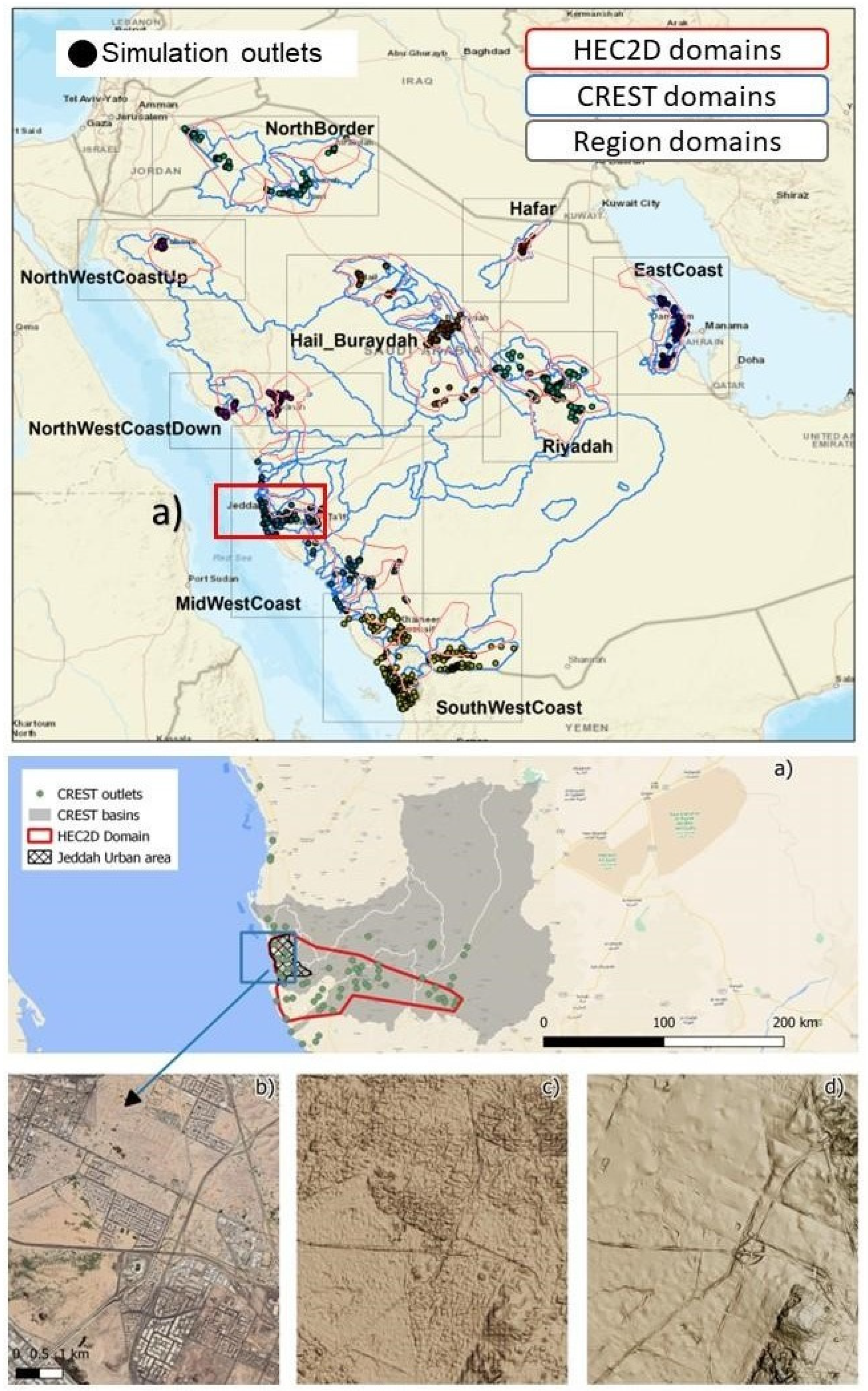




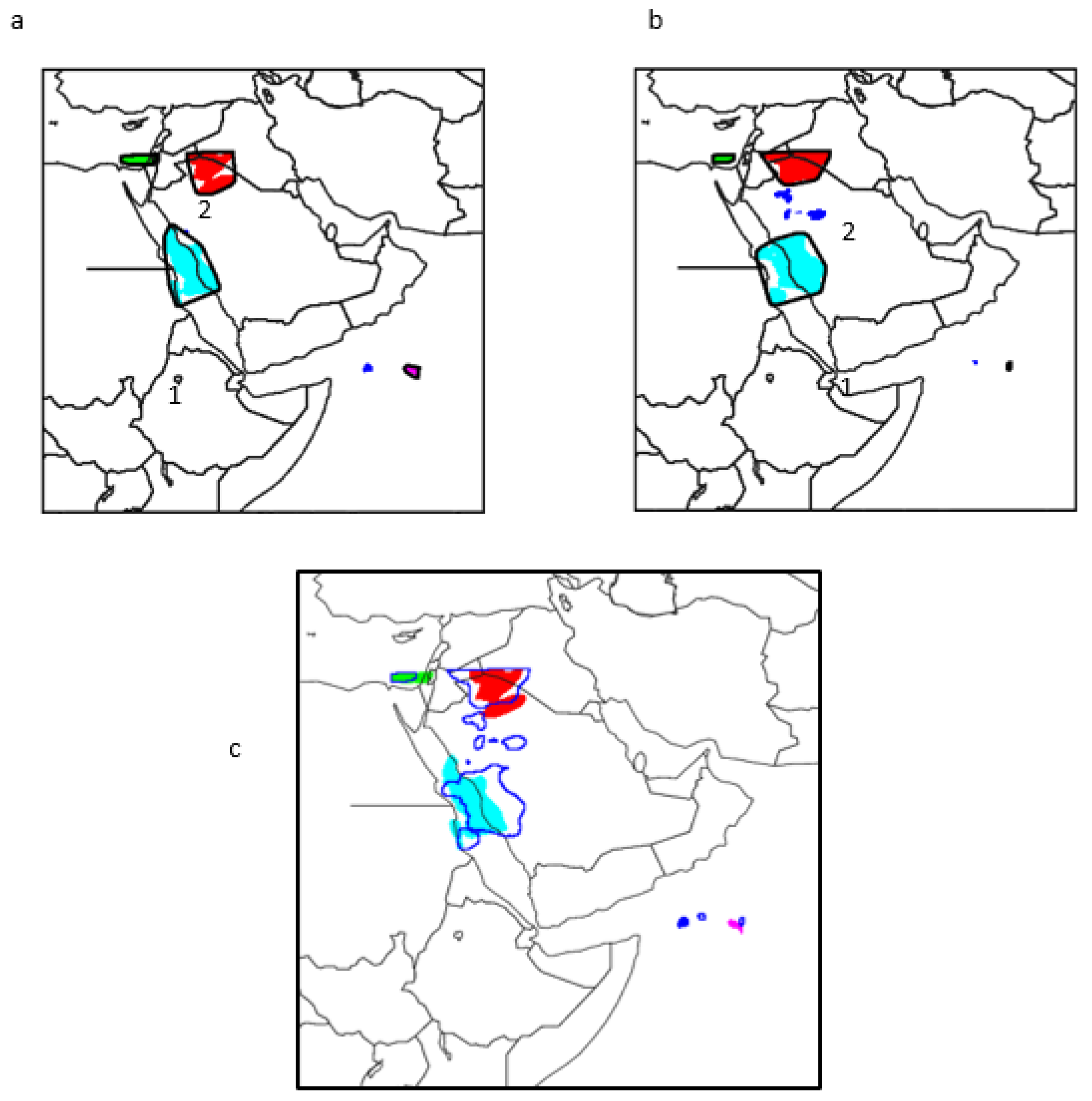


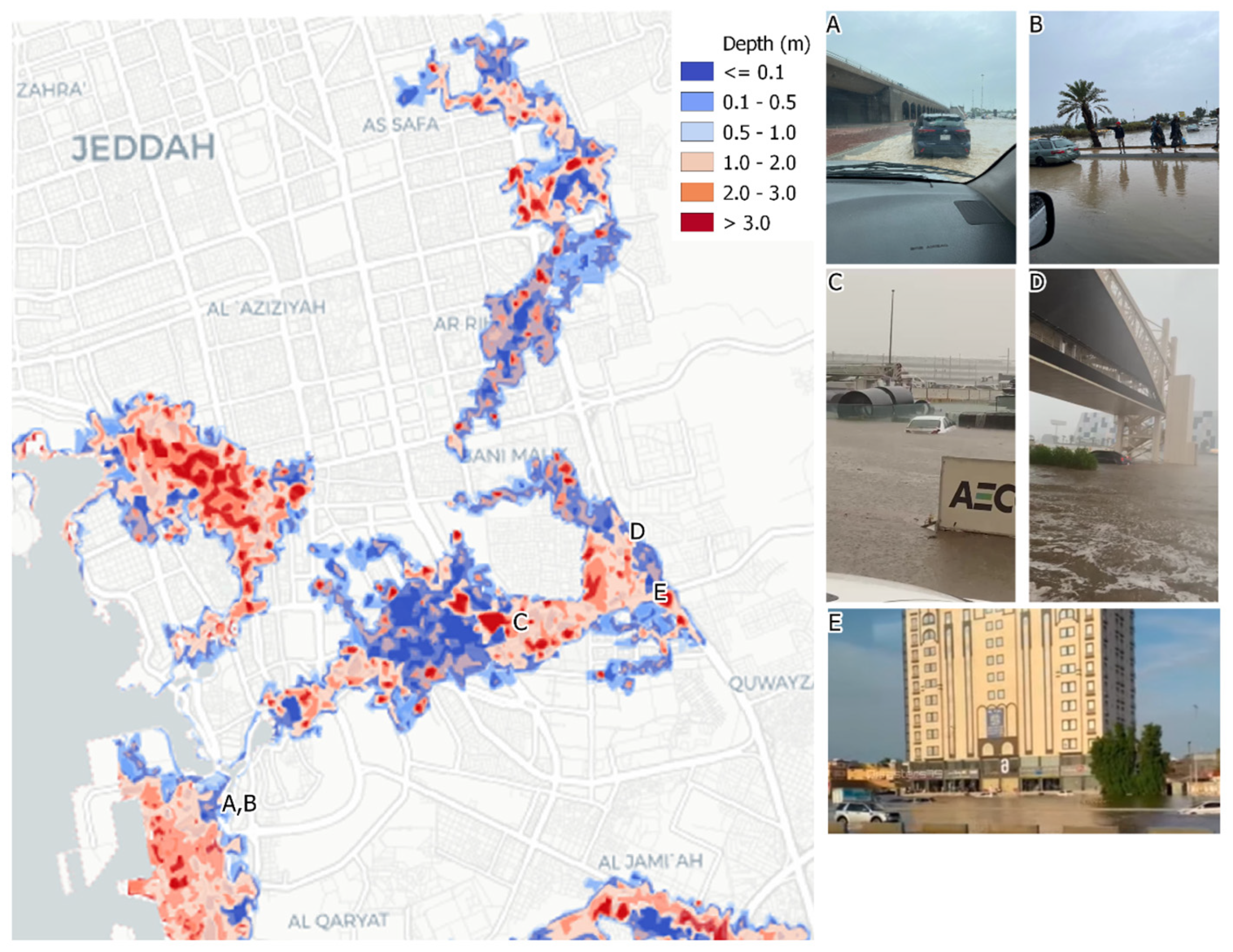


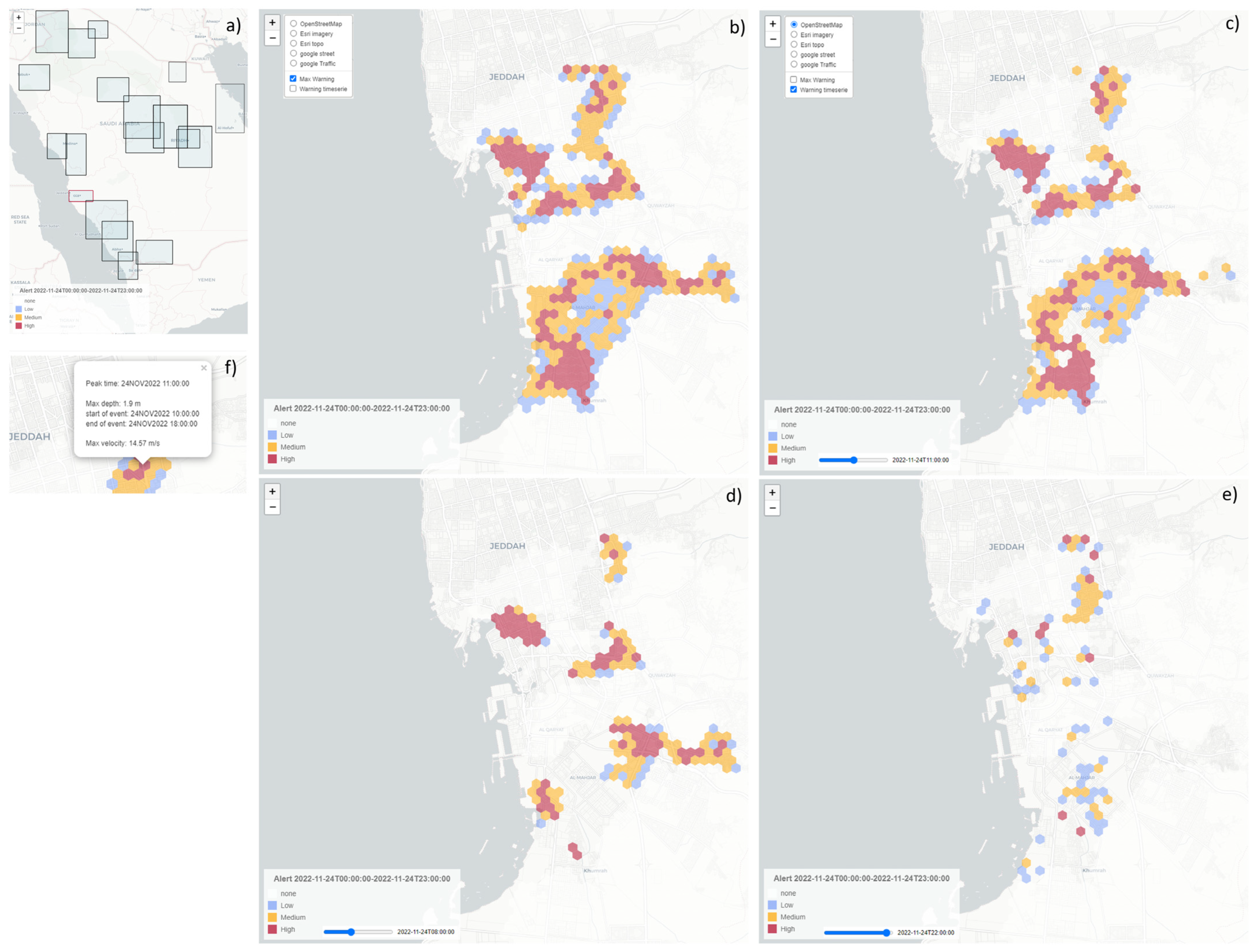

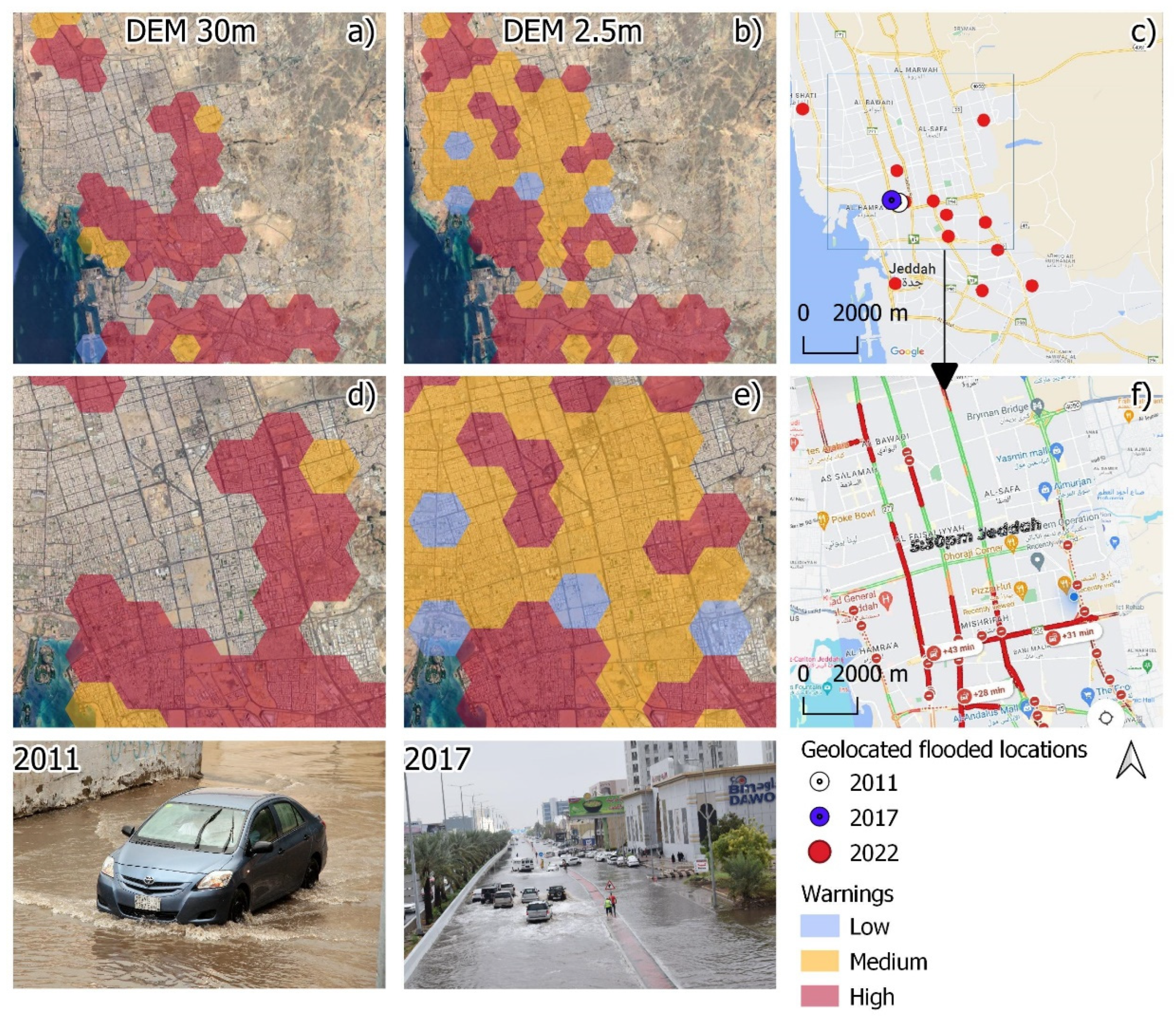
| Region | N. of Events |
|---|---|
| SouthWestCoast | 61 |
| MidWestCoast | 55 |
| Hail_Buraydah | 36 |
| Riyadh | 25 |
| NorthWestCoast | 23 |
| EastCoast | 22 |
| NorthBorder | 22 |
| NorthWestCoastDown | 15 |
| Hafar | 10 |
| NorthWestCoastUp | 4 |
| Total | 276 |
| Parameter | Tuned Value | Description | Reference |
|---|---|---|---|
| CoeM | 111.32 | The overland runoff velocity coefficient | [84] https://xinyi-shen.uconn.edu/wp-content/uploads/sites/2836/2019/11/CREST-User-Manual-v2.1.3.pdf, accessed on 26 June 2024 |
| ExpM | 0.55 | The overland flow speed exponent | |
| CoeR | 1.82 | The speed multiplier used to convert overland flow to channel flow | |
| CoeS | 0.58 | The speed multiplier used to convert overland flow to interflow | |
| KS | 0.95 | The overland reservoir discharge parameter | |
| KI | 0.33 | The interflow reservoir discharge parameter | |
| CoeSAT | 0.80 | The coefficient applies to adjust the saturation moisture | [83] |
| WRF | IMERG-Late | Radar | |
|---|---|---|---|
| Root mean square error | 7.35 | 7.99 | 7.89 |
| Mean error | 0.21 | 2.87 | −0.01 |
| Mean absolute error | 2.28 | 4.04 | 2.48 |
| Pearson | 0.60 | 0.58 | 0.43 |
| Bias ratio | 1.10 | 2.37 | 1.00 |
| Obj | Centroid Distance (km2) | Angle Diff (degrees) | FCST Area (km2) | OBS Area (km2) | Intersection Area (km2) | Union Area (km2) | Symmetry Diff (km2) |
|---|---|---|---|---|---|---|---|
| 1 | 112 | 1.1 | 17,080 | 22,000 | 12,020 | 27,060 | 15,040 |
| Discharge | Inundation Depth | |||
|---|---|---|---|---|
| Average | Max | Average | Max | |
| Root mean square error | 98.63 m3/s | 121.84 m3/s | 0.16 m | 0.90 m |
| Mean absolute error | 43.75 m3/s | 61.09 m3/s | 0.09 m | 0.90 m |
| Pearson | 0.95 | 0.97 | 0.72 | 0.95 |
| NSE | 0.76 | 0.82 | — | — |
Disclaimer/Publisher’s Note: The statements, opinions and data contained in all publications are solely those of the individual author(s) and contributor(s) and not of MDPI and/or the editor(s). MDPI and/or the editor(s) disclaim responsibility for any injury to people or property resulting from any ideas, methods, instructions or products referred to in the content. |
© 2024 by the authors. Licensee MDPI, Basel, Switzerland. This article is an open access article distributed under the terms and conditions of the Creative Commons Attribution (CC BY) license (https://creativecommons.org/licenses/by/4.0/).
Share and Cite
Sofia, G.; Yang, Q.; Shen, X.; Mitu, M.F.; Patlakas, P.; Chaniotis, I.; Kallos, A.; Alomary, M.A.; Alzahrani, S.S.; Christidis, Z.; et al. A Nationwide Flood Forecasting System for Saudi Arabia: Insights from the Jeddah 2022 Event. Water 2024, 16, 1939. https://doi.org/10.3390/w16141939
Sofia G, Yang Q, Shen X, Mitu MF, Patlakas P, Chaniotis I, Kallos A, Alomary MA, Alzahrani SS, Christidis Z, et al. A Nationwide Flood Forecasting System for Saudi Arabia: Insights from the Jeddah 2022 Event. Water. 2024; 16(14):1939. https://doi.org/10.3390/w16141939
Chicago/Turabian StyleSofia, Giulia, Qing Yang, Xinyi Shen, Mahjabeen Fatema Mitu, Platon Patlakas, Ioannis Chaniotis, Andreas Kallos, Mohammed A. Alomary, Saad S. Alzahrani, Zaphiris Christidis, and et al. 2024. "A Nationwide Flood Forecasting System for Saudi Arabia: Insights from the Jeddah 2022 Event" Water 16, no. 14: 1939. https://doi.org/10.3390/w16141939
APA StyleSofia, G., Yang, Q., Shen, X., Mitu, M. F., Patlakas, P., Chaniotis, I., Kallos, A., Alomary, M. A., Alzahrani, S. S., Christidis, Z., & Anagnostou, E. (2024). A Nationwide Flood Forecasting System for Saudi Arabia: Insights from the Jeddah 2022 Event. Water, 16(14), 1939. https://doi.org/10.3390/w16141939









